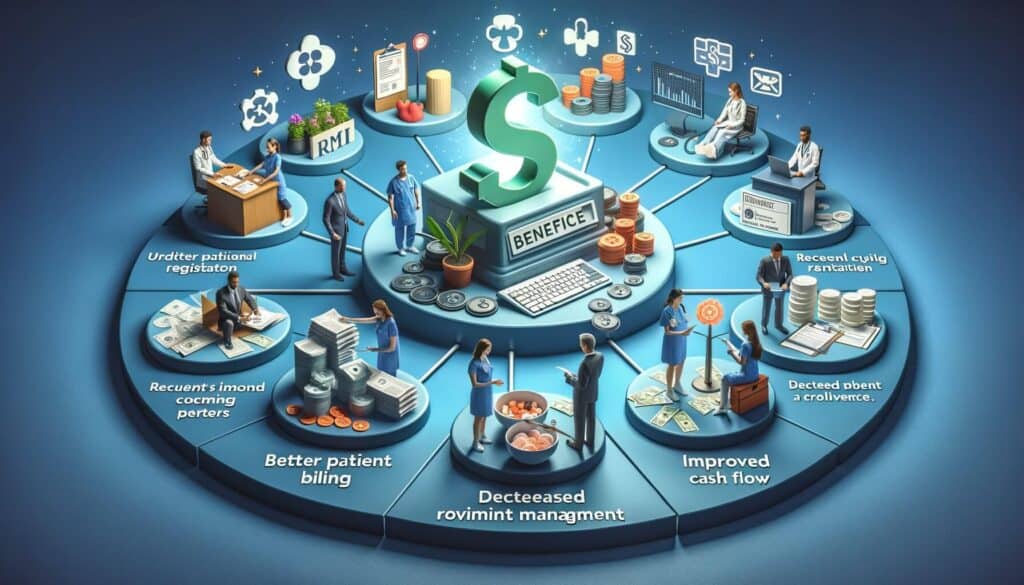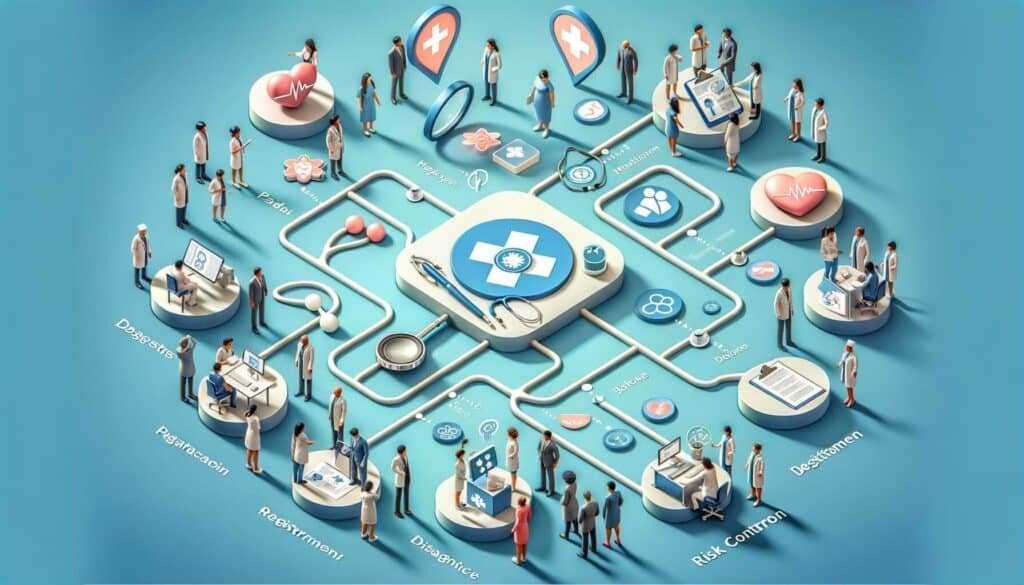
By American February 4, 2025
Revenue Cycle Management (RCM) is a crucial process in the healthcare industry that involves managing the financial aspects of patient care. It encompasses all the steps from scheduling an appointment to receiving payment for services rendered. Effective RCM ensures that healthcare organizations receive timely and accurate reimbursement for their services, ultimately improving their financial stability and patient care.
Understanding the Key Components of RCM

To fully grasp the concept of RCM, it is essential to understand its key components. These components include patient registration, insurance verification, charge capture, coding and documentation, claims submission, payment posting, denial management, and patient collections.
1. Patient Registration: The first step in the revenue cycle is patient registration. This involves collecting demographic and insurance information from the patient, which is crucial for accurate billing and reimbursement.
2. Insurance Verification: Once the patient is registered, the healthcare organization verifies the patient’s insurance coverage to determine the extent of their benefits and any potential limitations or requirements.
3. Charge Capture: Charge capture involves accurately recording the services provided to the patient, including procedures, tests, medications, and supplies. This information is essential for generating accurate claims and ensuring proper reimbursement.
4. Coding and Documentation: Coding and documentation play a vital role in RCM. Healthcare providers must accurately document the services provided and assign appropriate codes to ensure proper billing and reimbursement. This requires adherence to coding guidelines and staying updated with the latest coding changes.
5. Claims Submission: After coding and documentation, the healthcare organization submits claims to the insurance companies for reimbursement. This step requires careful attention to detail to avoid claim denials or delays.
6. Payment Posting: Once the insurance company processes the claim, the healthcare organization receives payment. Payment posting involves accurately recording the payment received and reconciling it with the billed amount.
7. Denial Management: Denial management is the process of identifying and resolving claim denials. It involves analyzing the reasons for denials, appealing denied claims, and implementing strategies to minimize future denials.
8. Patient Collections: Patient collections refer to the process of collecting payments directly from patients for services not covered by insurance or for their portion of the bill. This step requires effective communication and financial counseling to ensure timely and accurate payments.
Benefits of Implementing an Effective RCM System
Implementing an effective RCM system offers numerous benefits for healthcare organizations. These benefits include improved cash flow, increased revenue, reduced claim denials, enhanced patient satisfaction, and streamlined operations.
1. Improved Cash Flow: An effective RCM system ensures timely and accurate reimbursement, leading to improved cash flow for healthcare organizations. It reduces the time between providing services and receiving payment, minimizing financial strain.
2. Increased Revenue: By optimizing the revenue cycle, healthcare organizations can maximize their revenue potential. This includes capturing all charges, reducing claim denials, and effectively managing patient collections.
3. Reduced Claim Denials: Claim denials can significantly impact a healthcare organization’s revenue. An effective RCM system helps identify and resolve denial issues, reducing the number of denied claims and increasing the chances of successful appeals.
4. Enhanced Patient Satisfaction: A well-managed revenue cycle contributes to a positive patient experience. Patients appreciate accurate billing, transparent communication about their financial responsibilities, and timely resolution of any billing issues.
5. Streamlined Operations: Implementing an RCM system streamlines administrative processes, reducing manual tasks and improving efficiency. This allows healthcare organizations to focus on providing quality patient care rather than getting caught up in administrative burdens.
Step-by-Step Guide to Implementing RCM in Healthcare Organizations
Implementing an RCM system requires careful planning and execution. Here is a step-by-step guide to help healthcare organizations successfully implement RCM:
1. Assess Current Processes: Begin by assessing the current revenue cycle processes and identifying areas for improvement. This includes evaluating the efficiency of patient registration, charge capture, coding and documentation, claims submission, payment posting, denial management, and patient collections.
2. Set Goals and Objectives: Define clear goals and objectives for the RCM implementation. These goals should align with the organization’s overall financial and operational objectives. Examples of goals include reducing claim denials by a certain percentage or improving cash flow by a specific amount.
3. Establish Key Performance Indicators (KPIs): Identify key performance indicators (KPIs) to monitor the success of the RCM system. KPIs may include average days in accounts receivable, denial rate, clean claim rate, and collection rate. Regularly track and analyze these metrics to measure progress and identify areas for improvement.
4. Invest in Training and Education: Provide comprehensive training and education to staff members involved in the revenue cycle process. This includes front desk staff, coders, billers, and financial counselors. Ensure they have a thorough understanding of their roles and responsibilities, coding guidelines, and billing regulations.
5. Implement Technology Solutions: Leverage technology solutions to streamline and automate revenue cycle processes. This may include implementing an electronic health record (EHR) system, a practice management system, and a claims management system. These systems can improve accuracy, efficiency, and data analytics capabilities.
6. Enhance Communication and Collaboration: Foster effective communication and collaboration between different departments involved in the revenue cycle process. This includes establishing clear lines of communication, implementing regular meetings, and promoting a culture of teamwork.
7. Monitor and Analyze Performance: Continuously monitor and analyze the performance of the RCM system. Regularly review KPIs, identify trends, and implement necessary adjustments to optimize revenue cycle processes. This may involve conducting regular audits, performing coding and documentation reviews, and analyzing denial patterns.
8. Stay Updated with Regulatory Changes: Stay updated with the latest regulatory changes and coding guidelines. Compliance with regulations such as the Health Insurance Portability and Accountability Act (HIPAA) and the International Classification of Diseases (ICD) coding system is crucial for accurate billing and reimbursement.
9. Continuously Improve Processes: Implement a culture of continuous improvement within the organization. Encourage staff members to provide feedback, identify areas for improvement, and suggest innovative solutions. Regularly evaluate and update revenue cycle processes to adapt to changing industry trends and regulations.
Best Practices for Optimizing Revenue Cycle Management
To optimize revenue cycle management, healthcare organizations should follow these best practices:
1. Streamline Patient Registration: Implement efficient patient registration processes to collect accurate demographic and insurance information. Use electronic forms and automated verification tools to reduce errors and improve efficiency.
2. Ensure Accurate Coding and Documentation: Train coders and providers on accurate coding and documentation practices. Regularly audit coding accuracy and provide feedback to improve documentation quality.
3. Implement Real-Time Eligibility Verification: Use real-time eligibility verification tools to verify insurance coverage and benefits before providing services. This reduces claim denials and improves upfront collections.
4. Automate Claims Submission: Utilize electronic claims submission to reduce manual errors and expedite the reimbursement process. Electronic claims are processed faster, leading to quicker payment.
5. Implement Effective Denial Management Strategies: Develop a robust denial management process to identify and resolve claim denials promptly. Analyze denial patterns, implement corrective actions, and appeal denied claims when appropriate.
6. Offer Transparent Patient Financial Counseling: Provide patients with clear and transparent information about their financial responsibilities. Offer financial counseling services to help patients understand their insurance coverage, payment options, and potential financial assistance programs.
7. Optimize Patient Collections: Implement strategies to improve patient collections, such as offering convenient payment options, setting up payment plans, and utilizing automated payment reminders. Train staff members on effective communication and negotiation techniques.
8. Regularly Monitor Key Performance Indicators (KPIs): Continuously monitor and analyze KPIs to identify areas for improvement. Regularly review metrics such as denial rate, clean claim rate, and collection rate to measure the effectiveness of the RCM system.
Common Challenges in RCM and How to Overcome Them
Implementing and managing an effective RCM system comes with its fair share of challenges. Here are some common challenges in RCM and strategies to overcome them:
1. Complex Coding and Documentation Requirements: The ever-changing coding and documentation requirements can be challenging to navigate. To overcome this challenge, healthcare organizations should invest in regular training and education for coders and providers. They should also implement regular coding audits to ensure compliance and accuracy.
2. Claim Denials and Rejections: Claim denials and rejections can significantly impact revenue and cash flow. To overcome this challenge, healthcare organizations should implement effective denial management strategies. This includes analyzing denial patterns, identifying root causes, and implementing corrective actions. Regularly monitoring denial rates and implementing process improvements can also help reduce denials.
3. Inefficient Communication and Collaboration: Poor communication and collaboration between different departments involved in the revenue cycle process can lead to delays and errors. To overcome this challenge, healthcare organizations should establish clear lines of communication, implement regular meetings, and promote a culture of teamwork. Utilizing technology solutions that facilitate communication and collaboration can also improve efficiency.
4. Lack of Staff Training and Education: Inadequate training and education for staff members involved in the revenue cycle process can lead to errors and inefficiencies. To overcome this challenge, healthcare organizations should invest in comprehensive training programs. This includes training on coding guidelines, billing regulations, and the proper use of technology solutions. Regularly updating training materials and providing ongoing education can help staff members stay up-to-date with industry changes.
5. Limited Technology Integration: Lack of integration between different technology systems can hinder the efficiency of the revenue cycle process. To overcome this challenge, healthcare organizations should invest in technology solutions that seamlessly integrate with each other. This includes implementing an EHR system that integrates with a practice management system and a claims management system. Integration improves data accuracy, reduces manual tasks, and enhances overall efficiency.
The Role of Technology in Enhancing RCM Efficiency
Technology plays a crucial role in enhancing the efficiency of revenue cycle management. Here are some ways technology can improve RCM:
1. Electronic Health Record (EHR) Systems: EHR systems streamline the documentation process by allowing providers to electronically record patient encounters. This improves accuracy, reduces errors, and facilitates coding and billing processes.
2. Practice Management Systems: Practice management systems automate administrative tasks such as appointment scheduling, patient registration, and claims submission. These systems improve efficiency, reduce manual errors, and expedite the reimbursement process.
3. Claims Management Systems: Claims management systems automate the claims submission and processing workflow. They ensure accurate claim submission, reduce manual errors, and expedite reimbursement.
4. Revenue Cycle Analytics: Technology solutions that offer revenue cycle analytics provide valuable insights into the financial performance of healthcare organizations. These analytics help identify trends, measure key performance indicators, and identify areas for improvement.
5. Real-Time Eligibility Verification Tools: Real-time eligibility verification tools allow healthcare organizations to verify insurance coverage and benefits in real-time. This reduces claim denials and improves upfront collections.
6. Automated Payment Reminders: Automated payment reminder systems send timely reminders to patients about their outstanding balances. This improves patient collections and reduces the number of unpaid bills.
7. Telehealth and Remote Patient Monitoring: Telehealth and remote patient monitoring technologies enable healthcare organizations to provide virtual care services. These technologies expand access to care, increase patient engagement, and improve revenue opportunities.
RCM Metrics and Key Performance Indicators (KPIs) to Monitor
Monitoring key performance indicators (KPIs) is essential for measuring the success of an RCM system. Here are some important RCM metrics and KPIs to monitor:
1. Average Days in Accounts Receivable (ADAR): ADAR measures the average number of days it takes for a healthcare organization to receive payment after providing services. A lower ADAR indicates a more efficient revenue cycle process.
2. Denial Rate: Denial rate measures the percentage of claims denied by insurance companies. A lower denial rate indicates a more effective denial management process.
3. Clean Claim Rate: Clean claim rate measures the percentage of claims submitted without errors or omissions. A higher clean claim rate indicates accurate and complete claims submission.
4. Collection Rate: Collection rate measures the percentage of billed charges that are collected. A higher collection rate indicates effective patient collections and revenue optimization.
5. Net Collection Rate: Net collection rate measures the percentage of expected reimbursement that is actually collected. It takes into account contractual adjustments and write-offs. A higher net collection rate indicates efficient reimbursement processes.
6. First-Pass Resolution Rate: First-pass resolution rate measures the percentage of claims that are accepted and paid on the first submission. A higher first-pass resolution rate indicates accurate claims submission and reduced claim denials.
7. Accounts Receivable (AR) Aging: AR aging measures the age of outstanding accounts receivable. It categorizes outstanding balances based on the number of days since the claim was submitted. Monitoring AR aging helps identify potential bottlenecks and areas for improvement.
8. Cost to Collect: Cost to collect measures the cost incurred by a healthcare organization to collect payment for services rendered. Monitoring this metric helps identify opportunities for cost reduction and process improvement.
Frequently Asked Questions (FAQs)
Q1. What is Revenue Cycle Management (RCM)?
Revenue Cycle Management (RCM) is the process of managing the financial aspects of patient care in the healthcare industry. It involves all the steps from scheduling an appointment to receiving payment for services rendered.
Q2. Why is RCM important in healthcare organizations?
RCM is important in healthcare organizations because it ensures timely and accurate reimbursement for services provided. It improves cash flow, increases revenue, reduces claim denials, enhances patient satisfaction, and streamlines operations.
Q3. What are the key components of RCM?
The key components of RCM include patient registration, insurance verification, charge capture, coding and documentation, claims submission, payment posting, denial management, and patient collections.
Q4. How can healthcare organizations optimize their revenue cycle management?
Healthcare organizations can optimize their revenue cycle management by streamlining patient registration, ensuring accurate coding and documentation, implementing real-time eligibility verification, automating claims submission, implementing effective denial management strategies, offering transparent patient financial counseling, optimizing patient collections, and regularly monitoring key performance indicators (KPIs).
Q5. How can technology enhance RCM efficiency?
Technology can enhance RCM efficiency by providing electronic health record (EHR) systems, practice management systems, claims management systems, revenue cycle analytics, real-time eligibility verification tools, automated payment reminders, and telehealth and remote patient monitoring technologies.
Conclusion
Revenue Cycle Management plays a critical role in the financial success of healthcare organizations. By effectively managing the financial aspects of patient care, healthcare organizations can optimize revenue generation, reduce revenue leakage, and enhance patient satisfaction. Implementing an effective RCM system requires careful planning, staff training, and utilization of technology.
By following best practices and overcoming common challenges, healthcare organizations can ensure a streamlined revenue cycle and financial stability. As the healthcare industry continues to evolve, the future of Revenue Cycle Management lies in leveraging advanced technologies, such as artificial intelligence and automation, to further enhance efficiency and accuracy in revenue generation.
By embracing these advancements and continuously improving processes, healthcare organizations can navigate the complex financial landscape and thrive in the ever-changing healthcare environment.



